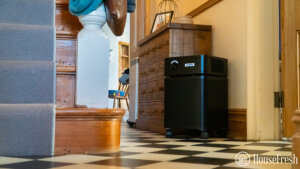Volatile organic compounds, or VOCs, regularly enter the home when you paint, clean, or even buy new furniture. The term ‘VOCs’ stands for volatile organic compounds, which are chemical gases emitted by some solid or liquid objects and can contain various chemicals, some harmful to human health.
Many VOCs are human-made chemicals used and produced in manufacturing pharmaceuticals, paints and refrigerants. VOCs can be created through chlorination in water treatments and contained in industrial solvents, pesticides, building materials and fuel.
These VOCs can enter our homes through common household products you use daily, such as paints, cleaning products, perfumes and nail polishes, among many others. And they can also enter our offices, through equipment like printers and photocopiers.
According to the U.S. Environmental Protection Agency, VOC concentrations can be up to ten times higher indoors than outdoors. Outside, VOCs usually dissipate without causing any harm. But, when indoors, these chemicals can linger and cause adverse health effects ranging from headaches and throat irritation to kidney and liver damage.

When this isn’t possible, another method of reducing VOC levels is using an air purifier that uses adsorption technology, usually with the help of a filter made of activated carbon.
To help, we have hand-picked our top recommendations for tackling VOCs indoors based on our own tests.
- In our home lab of 728 cubic feet, we light an incense stick to generate particle pollution and VOCs.
- We set up our trusted Purpleair Indoor Sensor with the latest Bosch gas sensor to track levels of PM1ug/m3, PM2.5ug/m3 and PM10ug/m3 and VOCs in the air.

- We switch the air purifier to its highest speed and measure how long it takes to get our room air quality down to PM1 level to 0.
- We use an energy meter to measure precisely how much electricity is used when running the unit at the lowest and highest fan speed settings.
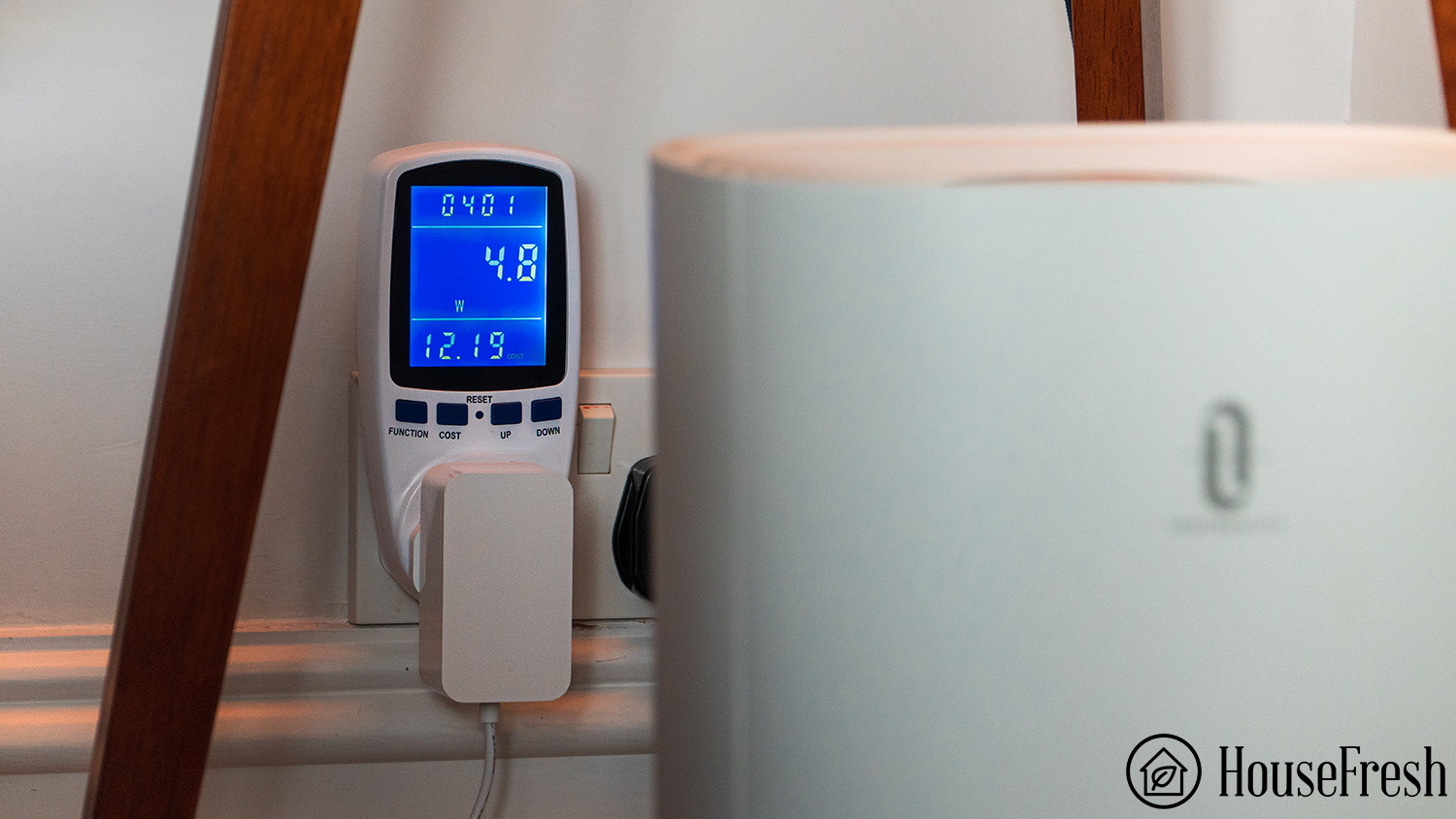
- We track sound levels emitted by the air purifier at different fan speeds with the help of a commercial sound meter.

Read more about our testing process and feel free to get in touch if you have any questions.
Staff picks: Top 3 air purifiers for VOCs
Below, you will find our top three air purifiers:
| 👑 BEST OVERALL | 💰 FOR TIGHT BUDGETS | 🛋️ FOR LARGE SPACES | |
|---|---|---|---|
| IQAir HealthPro Plus | Mila Air Purifier | Austin HealthMate | |
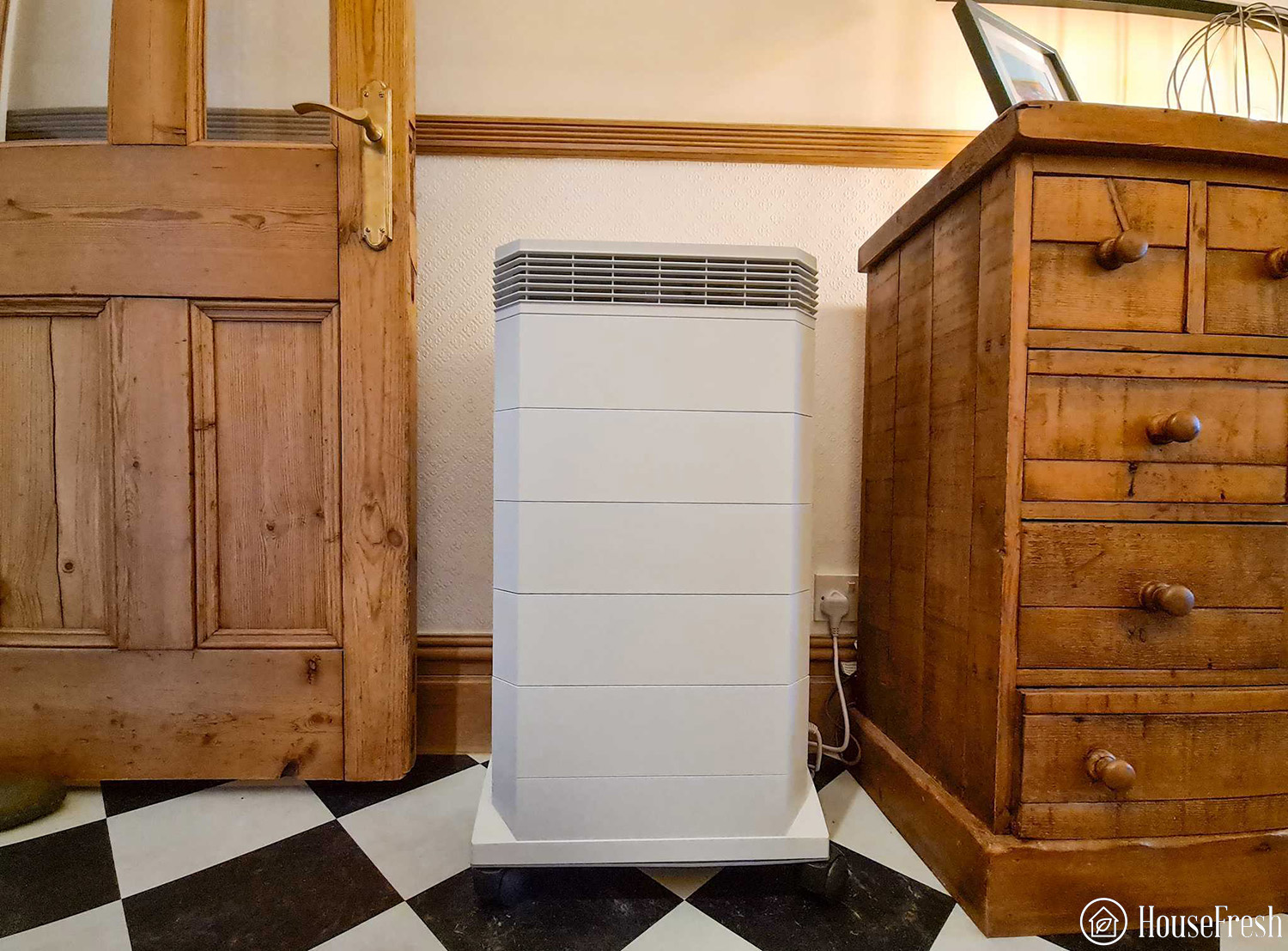 | 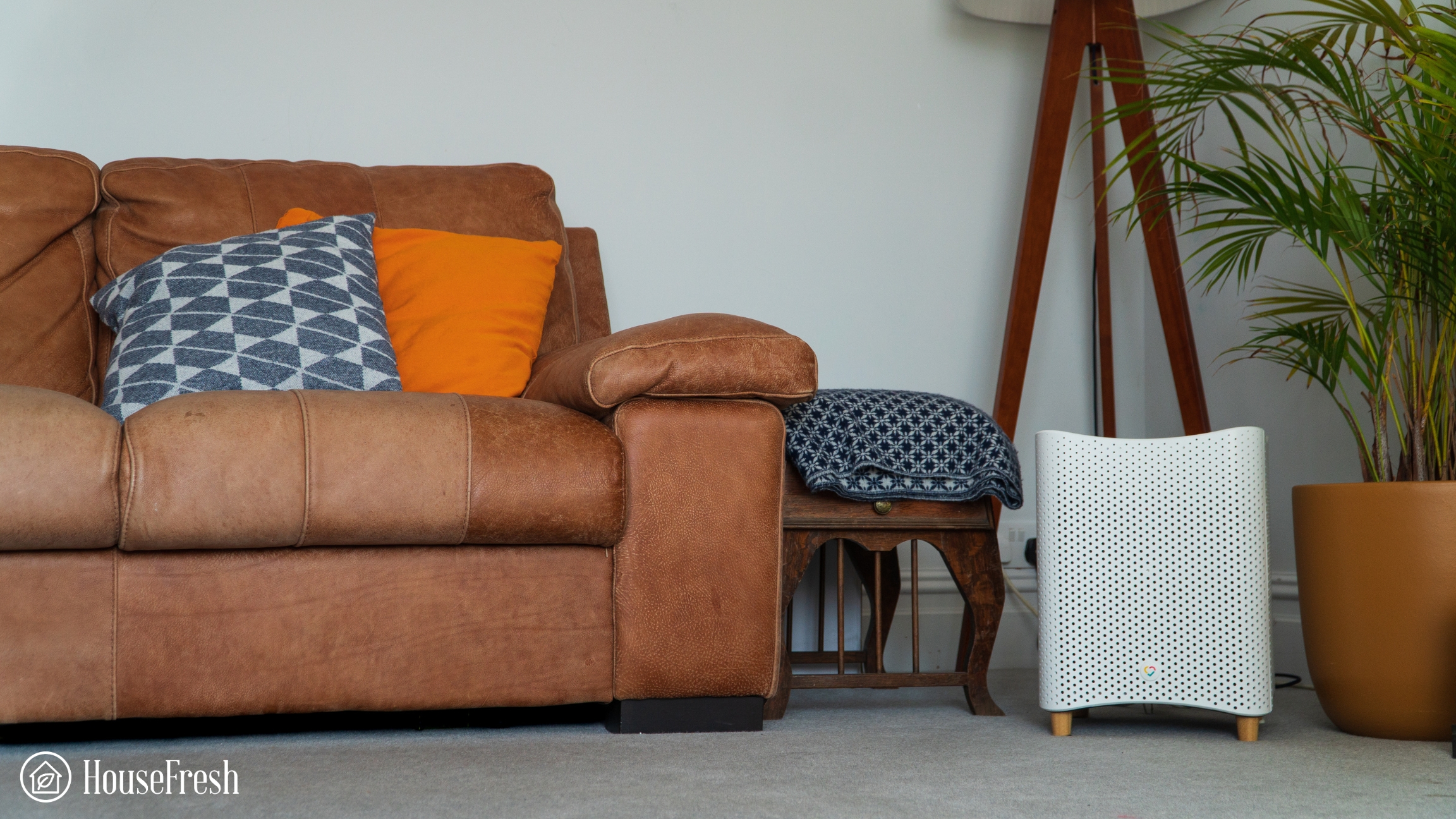 |  | |
| Air cleaning speed | 35 minutes | 35 minutes | 26 minutes |
| CADR rating | 300 CFM | 263 CFM | 400 CFM |
| Filter technology | Hyper HEPA and V5-Cell | H13 HEPA and The Critter Cuddler | HEPA and Activated Carbon |
| Activated carbon | 5 lbs | 0.84 lbs | 27 lbs |
| Max room size | 450 to 1125 sq. ft. | 1000 sq. ft. | 750 to 1500 sq. ft. |
| Weight | 35 Ibs | 18 lbs | 47 lbs |
| Our review | IQAir HealthPro Plus review | Mila Air Purifier review | Austin HealthMate review |
| Price | $899.00 | $439.99 | $715.00 |
Last update on 2024-04-26 / Affiliate links / Images from Amazon Product Advertising API
It’s important to clarify that most popular air purifiers are aimed at other air quality issues, such as pollen or cigarette smoke. Air purifiers won’t be as effective at dealing with VOCs unless packed with a large, activated carbon filter and a high-quality HEPA filter.
That is why you will see some units we don’t usually recommend here at HouseFresh that might not be the best for common household uses but will be highly effective against VOCs.
Read on to learn more about the five air purifiers we recommend for those looking to tackle VOCs indoors.
1. Best overall: IQAir HealthPro Plus
The IQAir HealthPro Plus is built to remove small particles, odors and VOCs. Its powerful filtration system captures ultrafine particles as small as 0.003 microns and its HyperHEPA technology stops at least 99.5% of these particles and pathogens.
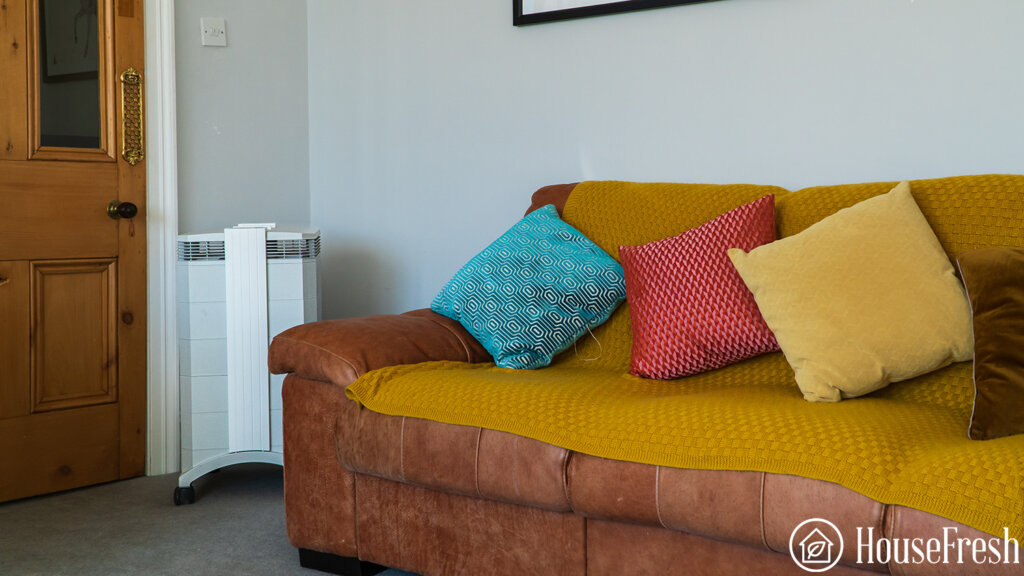
The IQAir HealthPro Plus has a large filter packed with nearly 5lbs of activated carbon. Combined with their HyperHEPA technology, this unit is the most efficient air purifier for tackling VOCs indoors.
What we really like
What we think could be better
Everything is kept airtight with this unit too. The filters are 100% sealed to prevent any air leakage. It offers 320° air delivery with minimum noise output on the lowest fan setting. There are six fan speeds in all, and it comes with a compact remote so you can adjust the speed, set up a timer and power the unit on and off.
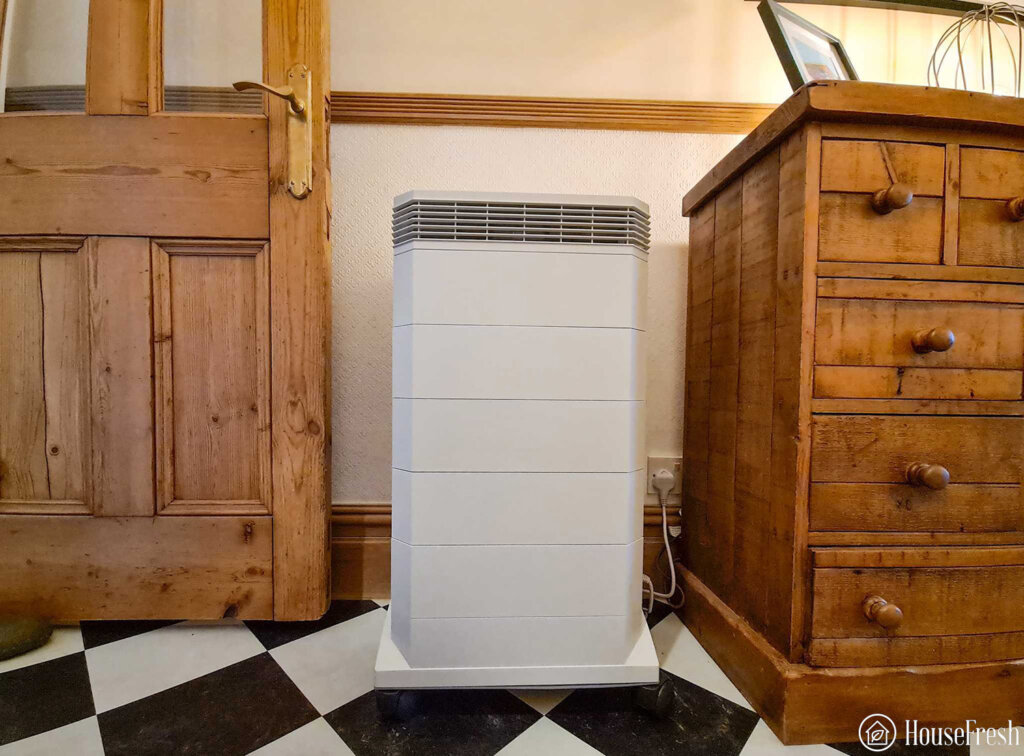
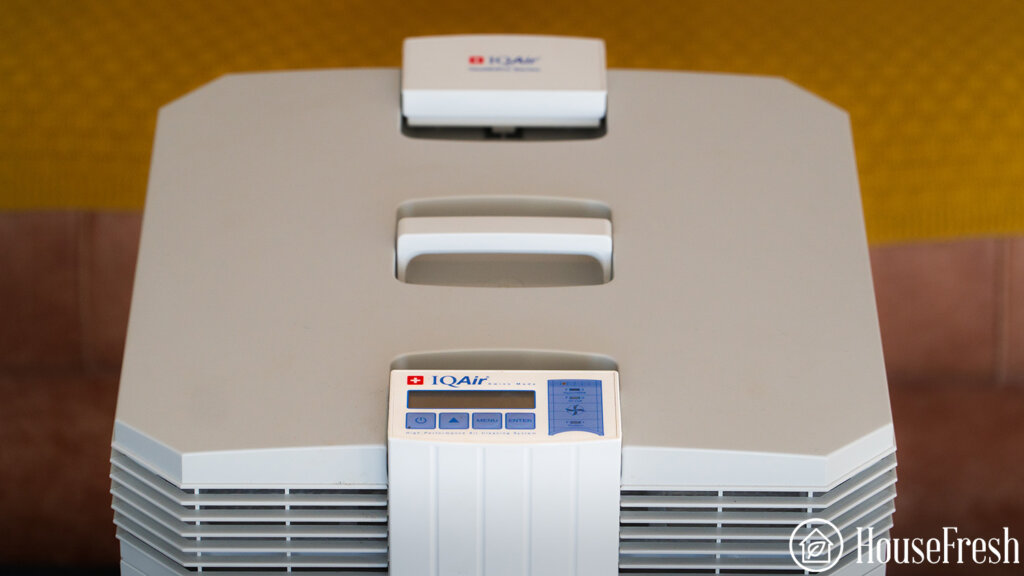

| HouseFresh rating: | ★★★★★ |
| Time to clean our 728 cubic feet test room (with the device running at top speed): | 24 minutes |
| Air purifier technology: | HyperHEPA and V50-CELL gas and odor filter |
| Recommended room size (4.8 air changes per hour): | 1125 sq. ft. |
| Clean air delivery rate (CADR): | Dust: 250 CFM |
| Dimensions (in inches / in cm): | 28H x 18W x 16D inches (71H x 38W x 41D cm) |
| Weight (in pounds / in kg): | 35 lbs (15.88 kg) |
| Filter life: | 4 years |
| Noise level (measured from 3 ft. away): | Speed 1: 36.9 dB Speed 2: 37.2 dB Speed 3: 40.9 dB Speed 4: 47.2 dB Speed 5: 53.9 dB Speed 6: 61.2 dB |
| Electricity consumption in watts (recorded with an electricity usage monitor): | Standby mode: 1 watts Speed 1: 16.5 watts Speed 2: 32.7 watts Speed 3: 47.3 watts Speed 4: 69 watts Speed 5: 94.3 watts Speed 6: 145.2 watts |
| Estimated running costs (electricity consumption + filter replacements): | $437.34 per year |
| Cost per CADR cfm (based on dust CFM as reported by AHAM): | $3.60 |
| Manufacturer’s warranty: | 10 years |
| Country of manufacture: | Switzerland / Germany |
2. Best for large rooms: Austin HealthMate
Austin Air Systems has been producing high-quality air purifiers since 1990 and has been voted the number air purifier made in the USA by HouseFresh experts. Their specialty is creating high-priced units focused on VOCs and chemicals — a niche in the air cleaning sector that most popular air purifier brands usually ignore.
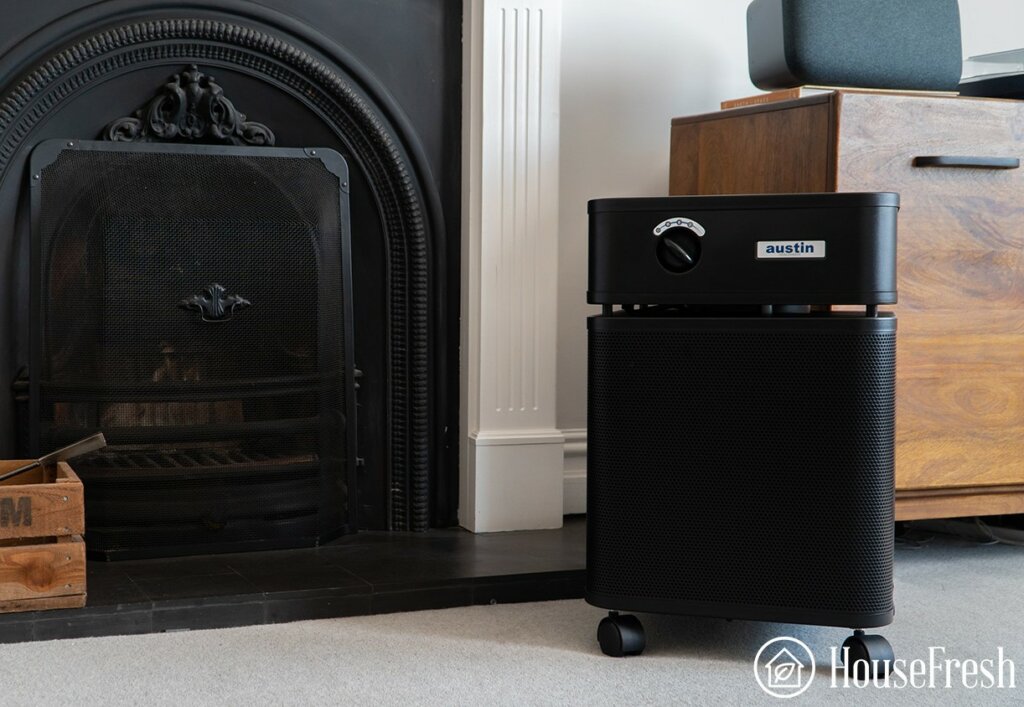
The Austin Healthmate comes with a filter with 15 lbs of activated charcoal, nearly three times the amount of activated charcoal that even the biggest air purifiers will include. A medical-grade HEPA filter can remove up to 99% of airborne pollutants as small as 0.1 microns, making the HealthMate able to deal with VOCs, bacteria, dust and other allergens.
What we really like
What we think could be better
Even though the HealthMade doesn’t come with any auto or sleep functions that other cheaper units include (hello, TaoTronics AP003), this air purifier stands out by its sheer performance regarding chemicals and odors.
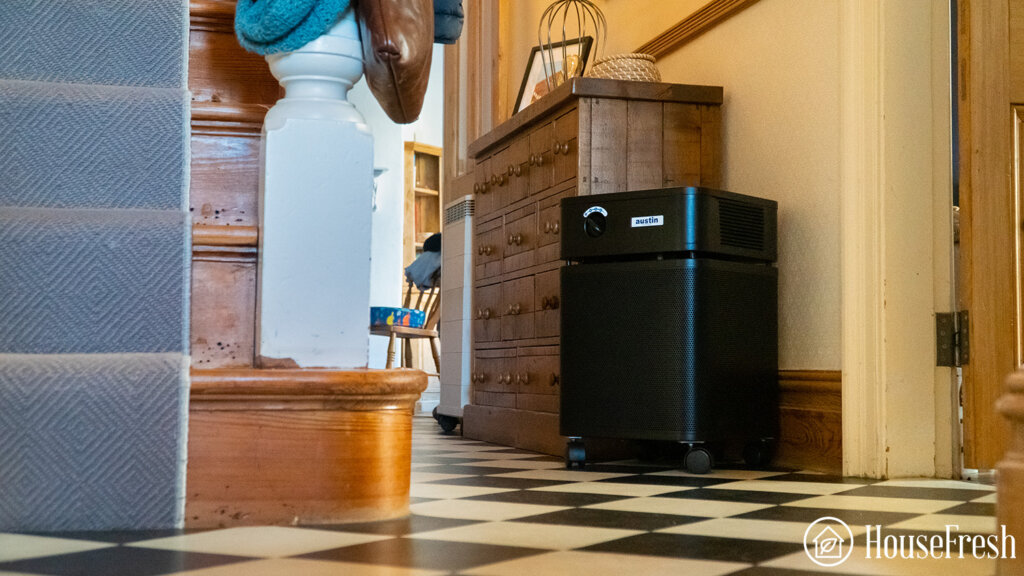
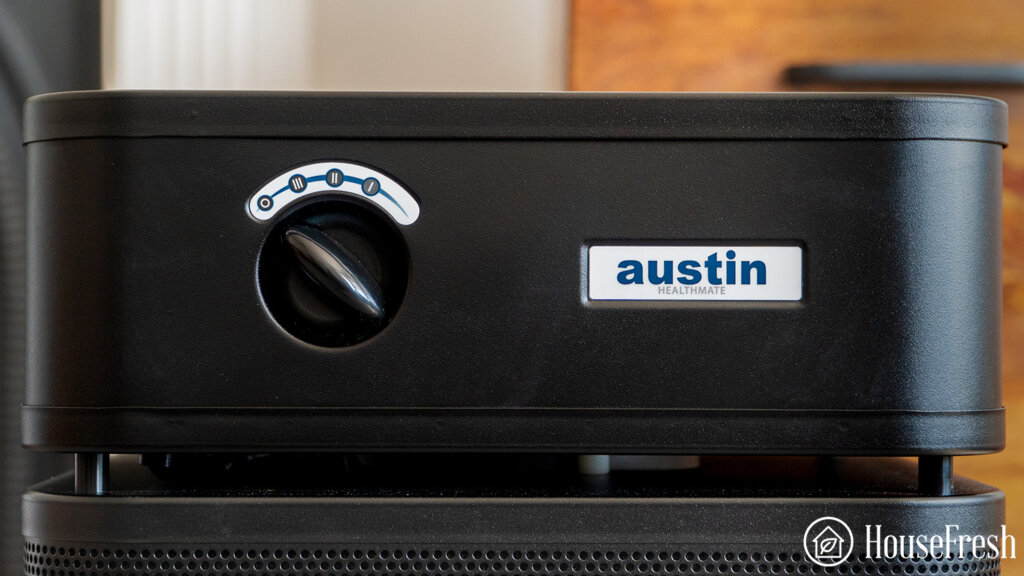

| HouseFresh rating: | ★★★★☆ |
| Time to clean our 728 cubic feet test room (with the device running at top speed): | 37 minutes |
| Air purifier technology: | Large particle pre-filter, medium particle pre-filter, HEPA filter and activated carbon filter |
| Recommended room size (estimated by HouseFresh to achieve 4.8 air changes per hour): | 234 sq. ft. |
| Clean air delivery rate (CADR): | Estimated: 150 CFM |
| Dimensions (in inches / in cm): | 23H x 14.5W x 14.5D inches (58.4H x 36.8W x 36.8D cm) |
| Weight (in pounds / in kg): | 20.41 lbs (9.26 kg) |
| Filter life: | 5 years |
| Noise level in decibels (measured from 3 ft. away with a sound level meter): | Speed 1: 42 dB Speed 2: 53.2 dB Speed 3: 61.5 dB |
| Electricity consumption in watts (recorded with an electricity usage monitor): | Standby mode: 0 watts Speed 1: 61.1 watts Speed 2: 85.05 watts Speed 3: 147.6 watts |
| Estimated running cost (electricity consumption + official filter replacement): | $254.56 per year |
| Cost per CADR cfm (based on dust CFM as reported by AHAM): | $4.80 |
| Manufacturer’s warranty: | 5 years |
| Country of manufacture: | U.S. (Buffalo, New York) |
3. Best budget option: Mila Air Purifier (with The Overreactor filter)
Mila is a smart air purifier that delivers. The moment you turn on your Mila, the air purifier analyzes the needs of your space with the help of its onboard air quality sensor, which can detect VOCs, CO2, CO1, PM1, PM2.5 and PM10 in real-time.

You can pick from several customizable filters when buying a Mila Air Purifier. Make sure to choose The Overreactor (the actual name of the filter) because it comes with 1.96 lbs of modified granular carbon. Hence, it is better equipped for dealing with volatile organic compounds (VOCs) and other chemicals.
What we really like
What we think could be better
The Mila performed well in our air cleaning test and cleaned the air from incense smoke pollutants in our home lab in under 35 minutes. This is the same cleaning power we saw in the Levoit Core 400S, but the Mila has a better filter option for VOCs.
Another benefit of this unit is that it looks great. This means you can set the unit up in different rooms around your home without wasting too much space or ruining your home décor.
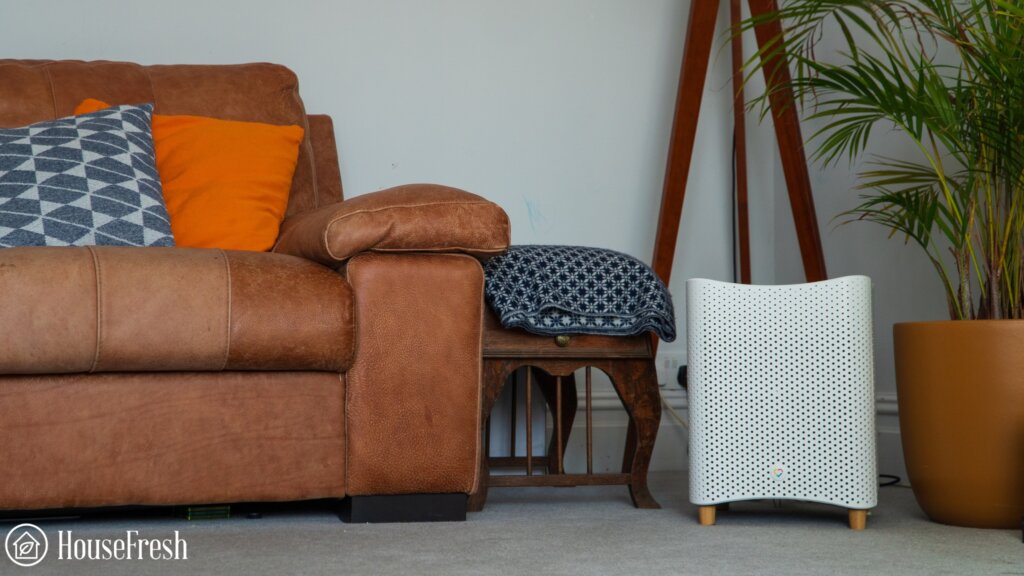
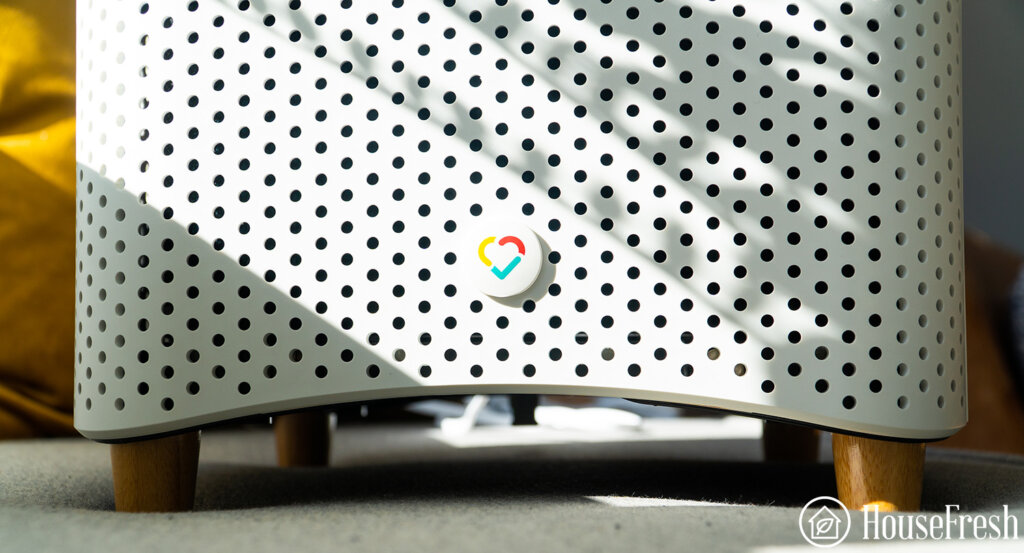
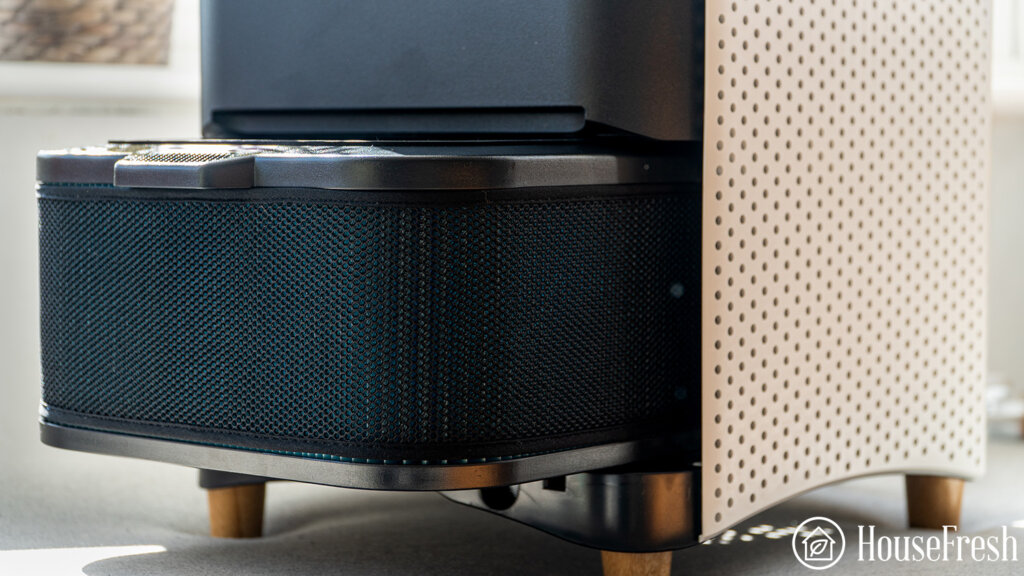
| HouseFresh rating: | ★★★★☆ |
| Time to clean our 728 cubic feet test room (with the device running at top speed): | 35 minutes |
| Air purifier technology: | HEPA (ranges from H12-H14) and ganular activated carbon filter |
| Recommended room size (4.8 air changes per hour): | 217 sq. ft. |
| Clean air delivery rate (CADR): | Dust: 146 CFM Smoke: 140 CFM Pollen: 152 CFM |
| Dimensions (in inches / in cm): | 12L x 12W x 15H inches (30.48L x 30.48W x 38.1H cm) |
| Weight (in pounds / in kg): | 18 lbs (8.16 kg) |
| Filter life: | 6 months |
| Noise level in decibels (measured from 3 ft. away with a sound level meter): | Speed 1: 37.5 dB Speed 3: 42.2 dB Speed 6: 54.8 dB Speed 8: 58.8 dB Speed 10: 59.2 dB |
| Electricity consumption in watts (recorded with an electricity usage monitor): | Standby mode: 5.62 watts Speed 1: 8.42 watts Speed 3: 10.1 watts Speed 6: 20.45 watts Speed 8: 36.2 watts Speed 10: 38.32 watts |
| Estimated running cost (electricity consumption + official filter replacement): | $202.56 per year |
| Cost per CADR cfm (based on dust CFM as reported by AHAM): | $3.22 |
| Manufacturer’s warranty: | 1 year |
| Country of manufacture: | China |
4. Smart Blast Mini (with Activated Carbon Filter)
Smart Air may not be as well known in the air purifier market as some of the more prominent brands. Still, they’re making big waves with their high-performance units focused solely on cleaning the air in your home over fancy smart features and gadgetry.
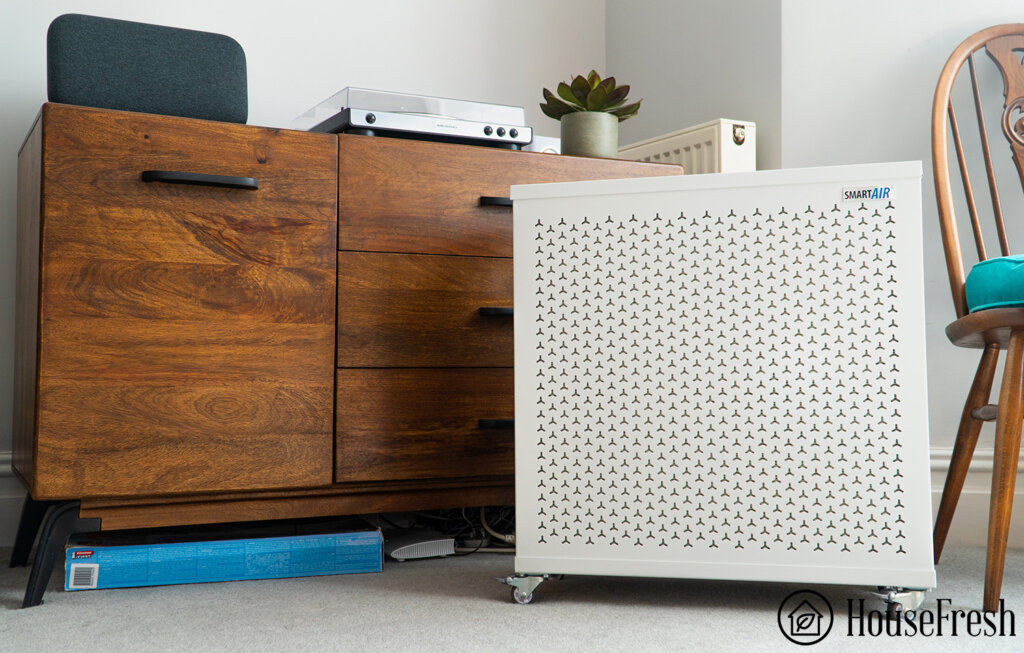
The Blast Mini is one of their finest examples of a unit that can easily tackle VOCs in rooms up to 915 sq. ft. with its huge fan and powerful motor that produces an impressive CADR score of 435 CFM.
Encased in its durable metal exterior is a large medical-grade H13 HEPA filter to capture harmful airborne particles in your home. Unfortunately, the Blast Mini doesn’t come with an Activated Carbon filter as standard, so to remove VOCs, you’ll need to upgrade your purchase to add it.
What we really like
What we think could be better
This 6.6lbs (overall weight) carbon filter is packed with a massive surface area of carbon granules, making it ideal for removing formaldehyde, paint odor, smoke and other VOCs from your air.

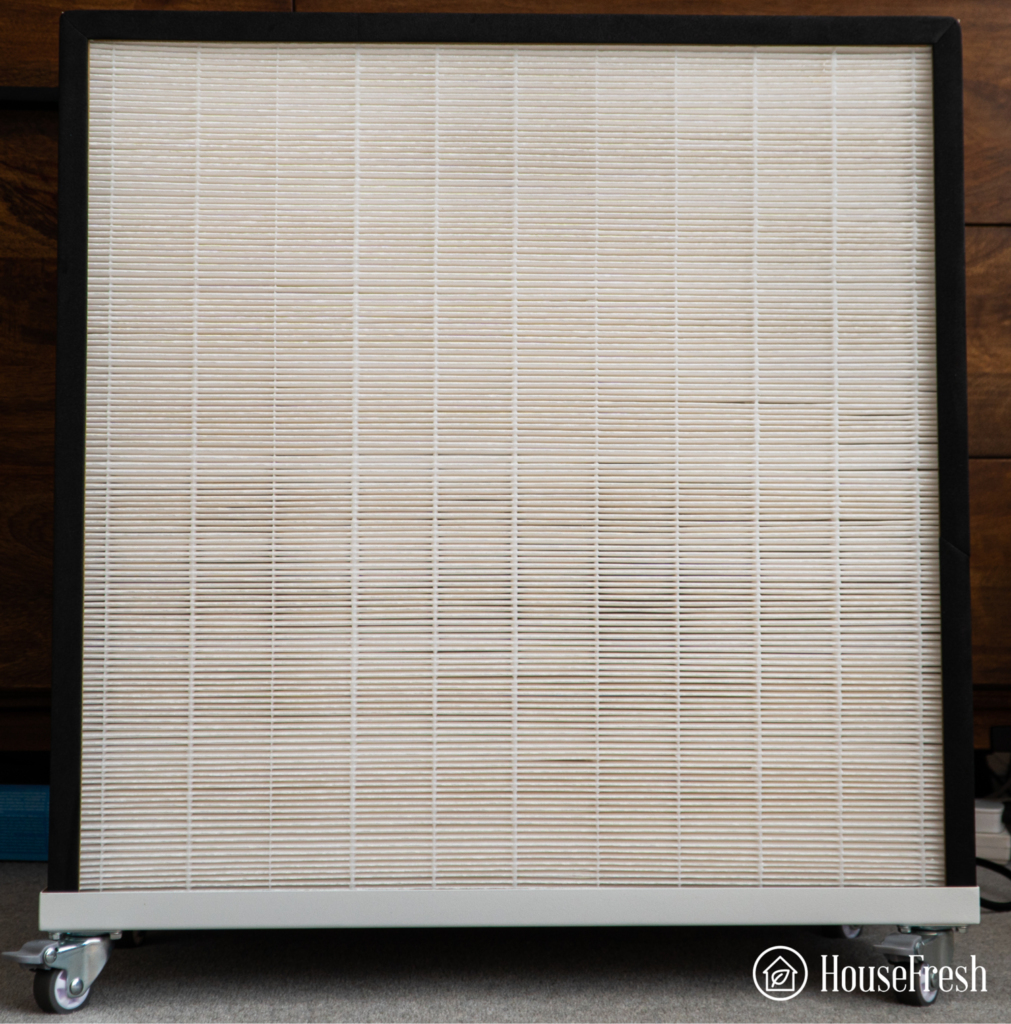

| HouseFresh rating: | ★★★★☆ |
| Time to clean our 728 cubic feet test room (with the device running at top speed): | 12 minutes |
| Air purifier technology: | H13 HEPA Filter |
| Recommended room size (4.8 air changes per hour): | 703 sq. ft. |
| Clean air delivery rate (CADR): | 435 CFM |
| Dimensions (in inches / in cm): | 22.6L x 13W x 24.8H inches (57.5L × 33W × 63H cm) |
| Weight (in pounds / in kg): | 59 lbs (26.8 kg) |
| Filter life: | 33 months |
| Noise level in decibels (measured from 3 ft. away with a sound level meter): | Speed 1: 44.9 dB Speed 2: 51.2 dB Speed 3: 56.3 dB |
| Electricity consumption in watts (recorded with an electricity usage monitor): | Standby mode: 0 watts Speed 1: 51.9 watts Speed 2: 87.4 watts Speed 3: 122.7 watts |
| Estimated running cost (electricity consumption + official filter replacement): | $277.70 per year |
| Cost per CADR cfm (based on dust CFM as reported by AHAM): | $1.38 |
| Manufacturer’s warranty: | 1 year |
| Country of manufacture: | China |
5. Alen BreatheSmart 75i
Alen has been producing Ture HEAP air purifiers that everyone trusts and rates highly since 2005, and the Alen 75i is the flagship model of their bestselling air purifiers.
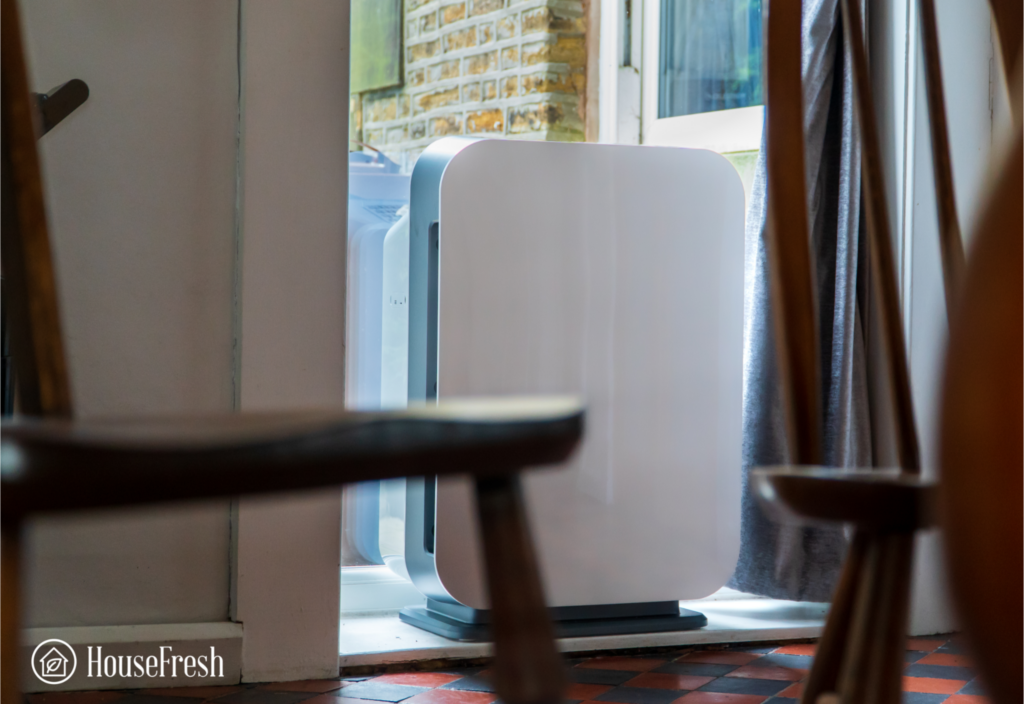
When buying an Alen BreatheSmart 75i, you will be prompted to choose a filter from three options designed to tackle different air quality issues. When purifying the air from VOCs, you have to go for Alen’s B7-Fresh True HEPA Filter, which comes with an H13 True HEPA filter plus the power of activated carbon for added protection against volatile organic compounds (VOCs).
What we really like
What we think could be better
As with the other air purifiers we recommend for VOCs, the Alen BreatheSmart 75i doesn’t come cheap but if you do pick the subscription service for filters, they will give you a lifetime warranty on all of their air purifiers when you buy from Alen.com
We still have an Alen A350 from 2010 that performs pretty well if a little energy-inefficient so you can expect their purifiers to keep running for the long term.
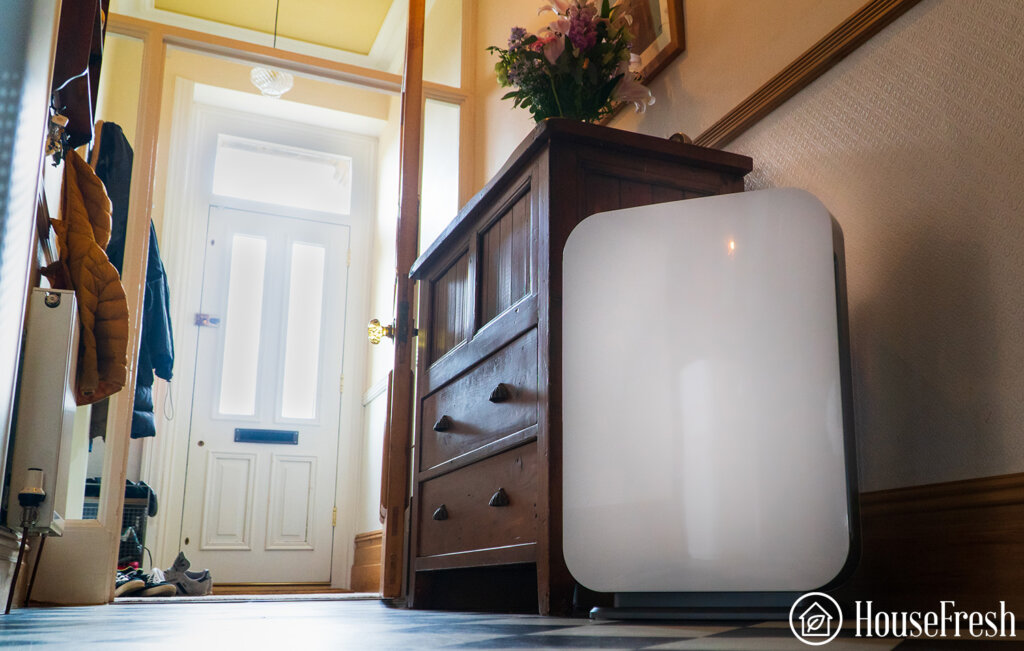


| HouseFresh rating: | ★★★★☆ |
| Time to clean our 728 cubic feet test room (with the device running at top speed): | 24 minutes |
| Air purifier technology: | True HEPA H13 filters with activated carbon pellets + Ionizer technology |
| Recommended room size (4.8 air changes per hour): | 512 sq. ft. |
| Clean air delivery rate (CADR): | Dust: 335.3 CFM Smoke: 330.5 CFM Pollen: 403.4 CFM |
| Dimensions (in inches / in cm): | 27H x 18.5W x 11.5D inches (68.58H x 46.99W x 29.21D cm) |
| Weight (in pounds / in kg): | 27 lbs (12.2 kg) |
| Filter life: | 12 – 15 months |
| Noise level in decibels (as reported by the manufacturerv): | 24 – 49dB |
| Electricity consumption in watts (as reported by the manufacturerv): | Lowest fan speed: 1.8 watts Highest fan speed: 45 watts |
| Estimated running cost (electricity consumption + official filter replacement): | $197.30 per year |
| Cost per CADR cfm (based on dust CFM as reported by AHAM): | $2.23 |
| Manufacturer’s warranty: | Lifetime (with product registration & active filter subscription) |
| Country of manufacture: | China |
What to look for when buying an air purifier for VOCs
From irritating your eyes and throat to damaging your organs and nervous system, the dangers of VOCs can be severe and must be addressed. Your best option is to pick an air purifier specifically designed to absorb these hazardous chemicals.
Whether an air purifier can remove VOCs depends completely on the filter inside. Since VOCs are emitted in a gaseous state, they can easily be absorbed from the air by the right filter. Thus, an air purifier for VOCs is specifically designed to remove these harmful airborne particles and chemicals from the air.
The problem for those looking to buy an air purifier for VOCs is that most units on the market use HEPA or a dual ionizer/HEPA filter and these do very little to remove gases like VOCs from the air.
1. Choose an air purifier with a large amount of activated carbon
Activated carbon is simply carbon that has been oxidized to create millions of ultra-wide pores that can absorb gas molecules effectively. You can mainly remove VOCs with the help of powerful activated carbon filters, as these will trap gasses and vapors in addition to smells associated to smoke, pets and cooking.
The downside to this type of filtration is that you need large amounts of activated carbon to deal with lots of VOCs, as the amount of gasses an activated carbon filter can deal with is directly connected to the quantity of activated charcoal in the filter itself.
That is why you should aim for an air purifier with as much activated carbon as possible.
| Did you know? A study by the University of Reading in England tested and compared different filter technologies, showing that adsorption filter technology (like that of activated carbon filters) is the most efficient at removing volatile organic contaminants like formaldehyde, benzene, and ammonia. |
2. Ensure the air purifier’s recommended room size matches the space you want to purify
You should always check the manufacturer’s guidelines for the recommended room size for the unit you’re considering. Still, it is even more important when tackling a severe issue such as VOCs indoors. The air purifier wouldn’t work as effectively as it could if you placed it in a room larger than the size it can handle.
Even though it might feel like a drag, take the time to measure the space where you will be placing the unit to ensure it matches the manufacturer’s recommendation.
The best way to know whether a unit will do a good job in the room you intend to use it in, is to use our calculator to see what CADR rating you should look for:
3. Don’t fret over smart features
The latest air purifiers usually include an array of smart features to simplify the process on the user’s end. For instance, air purifiers boasting a ‘smart mode’ will automatically turn on and adapt fan speed levels depending on the air quality in the home in real time.
The reality, however, is that your air purifier will need to run at full speed to remove VOCs from the air. Therefore, this smart feature is not a requirement for this device. You will be the best person to turn the unit on and blast it at full speed for the duration of your stay in the affected room.
4. Consider noise levels if you’re sensitive to sound
Since your device will likely run at full speed 24/7 while dealing with VOCs in the air, you must consider the associated noise level before purchasing it. If you want an air purifier with an acceptable sound level, consider purchasing one with a high CADR to ensure it comes with a powerful fan that runs smoothly at top speeds. It is also worth looking for the unit with the lowest decibels (dB) at the highest fans speed – all this info is in the specs table below the units on this list.
There are quiet air purifiers, but sadly many don’t use a large amount of activated charcoal, so they are not a good fit for removing VOCs.
5. If you’re conscious of your energy bill, pay attention to power consumption levels
As I mentioned above, when dealing with VOCs, you will use our air purifier at full speed for extended periods. This means that electricity consumption can become an issue. The cost of electricity is rapidly rising, so being wary of power consumption can pay off in the long run.
When researching, check the air purifier’s power consumption specs before purchasing it. We test energy consumption ourselves and turn the KW figure into yearly cost using the Department of Energy’s appliance energy calculator so pay attention to that figure under the ‘estimated energy consumption’ row of the specs table below the units we’ve shortlisted.
6. Keep unit costs in mind but also calculate replacement filter costs
These devices are costly, especially the ones that use large amounts of activated carbon. Therefore, ensure that you check the cost of the device and the replacement filter cost. For effectiveness, air purifier filters must be replaced regularly, so ensure your choice fits your budget.
Common questions about VOCs and air purifiers
When we speak about VOCs, many of them are ubiquitous pollutants that can be found in any home. You will have a higher chance of being exposed to these while sitting inside your home than you ever will be while going outside.
Many of them can vaporize at room temperature, but they can potentially harm your health if they are in high concentrations. How harmful also depends on how long the exposure has been going on.
The Environmental Protection Agency reports regular or prolonged exposure to these volatile organic compounds or VOCs can have nasty health implications.
They may include:
- Eye, nose and throat irritation
- Headaches, loss of coordination and nausea
- Damage to the liver, kidney and central nervous system
- Some organics can cause animal cancer, while others are suspected or known to cause cancer in humans.
Common sources of VOCs in the home include:
| 🚧 Building materials | VOCs can be found in paint, caulks, adhesives, vinyl flooring, insulation materials, and composite wood products. |
| 🧴 Household Products | Common household products such as air fresheners, fuel and cleaning products emit VOC compounds in the air. |
| 💅 Personal Care Products | Formaldehyde is the most common type of VOC. It is found in many products we use daily at home, including nail polish! |
| 🍳 Daily Activities | Some daily activities and habits like cooking, dry cleaning, photocopying, burning wood, and smoking also release VOCs into the air. |
If an air purifier has a large enough amount of activated charcoal, then it will be able to remove VOCs from the air. Our current favorite is the IQAir Healthpro Plus and Levoit Everest.
HEPA can only remove particulate pollutants from the air like dust, dirt or pollen. VOCs are gas, so activated charcoal is the best current technology for removing them from the air. Be wary of technology like UV-C as it has been shown to generate chemical byproducts like ozone during cleaning.
Yes, activated charcoal has been used for decades to remove gas pollutants. The particles inside the activated charcoal trap the gas and eventually become full. This means activated charcoal filters will need replacing every 6 months to a year, especially when used in highly polluted spaces.
The easiest way to test for VOCs is with an air quality monitor – we found the QP Lite performs well, has a respected sensor, and won’t cost more than $100. For our performance tests, we use the latest Purple air indoor sensor that includes a gas sensor from Bosch for detecting VOCs.
Wrapping up
Air purifiers aren’t difficult to find, but when you want them to handle volatile organic compounds (VOCs), you must pay extra attention to the filters. HEPA filters are popular but unable to handle such chemicals in the air, so you want to choose an air purifier with a large amount of activated charcoal.
If you can afford it, then our top choice is the IQAir HealthPro Plus, hands down.
Last update on 2024-04-26 / Affiliate links / Images from Amazon Product Advertising API




